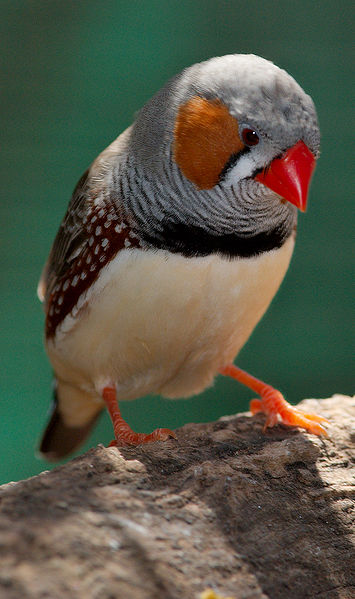
Click
here to read the first part of this article
Song Recognition
It seems that song recognition, on the other hand, is instinctive – female birds of all species tested respond (with an increased heart rate!) to the songs of males of the same species. Male birds of the same species, but living in different places, develop local “dialects” – similar, perhaps, to the differences between the accents of people raised in NYC and Dallas. Female birds usually recognize the song of any male of their species, but respond with increased interest (again, the heartbeats) to songs from “neighborhood” males (sorry, I do not know if any conclusions pertaining to people can be drawn!).
Zebra Finches in the Wild
We are so accustomed to seeing zebra finches in cages that it is easy to overlook their existence as vital members of a natural environment. However, free-living zebra finches are perhaps the most abundant birds in the interior of their native Australia. With the exception of coastal Victoria and New South Wales, they inhabit the entire continent. In fact, their range is expanding due to the provision of water (they must drink daily) on livestock farms. A subspecies of the zebra finch (which was actually the first member of the species to be brought into captivity), the Lesser Sunda zebra finch, occupies nearby Timor and the Lesser Sunda Islands.
Classification
Despite their common name, zebra finches are not true finches but rather are classified as waxbills, in the family Estrildidae. Nearly 150 species of waxbills range throughout Africa, Asia and Australia. A number of the zebra finch’s relatives, including the gouldian finch, the cordon blue and the white-backed munia, are also popular in the pet trade. The nearly 200 species of true finches (family Fringillidae) are absent from Australia.
Habitat and Adaptations
Zebra finches favor open woodlands, grasslands and farms, but can also be found in Australia’s harsh, arid interior scrublands. They feed mainly upon seeds, especially those of various grasses, and take insects as well. Populations living in salt marshes have evolved the ability to drink salt water – excreting excess sodium via the kidneys. They are fairly sensitive to temperature and cannot generate enough heat for egg incubation if temperatures fall below 53 F.
Breeding
Like many of its relatives, the zebra finch forages in large flocks. Within the flock, however, monogamous pairs form. The pair bond appears, in most cases, to be life-long. Breeding is sporadic throughout the year and may not occur at all during droughts. As an adaptation to the harsh environment, this species has evolved the ability to breed quickly at the onset of rains during nearly any time of the year.
Zebra finches nest as discrete pairs, but communally – that is, with many pairs occupying the same tree. The female chooses the nest site and constructs the nest with dried grasses and other materials brought by the male. The 4-5 eggs are incubated by both parents and hatch in 13-16 days. The young, fed by the male and female, fledge in 20-21 days. In years with favorable rainfall and food supplies, 3 or more broods may be raised. The zebra finch’s ability to take advantage of good conditions can be a handicap in captivity – in response to the abundance of food and water, females may lay so often that their health suffers (this problem can be ameliorated somewhat by removing all nesting material).
A View from Taiwan
As mentioned earlier, zebra finches are popular pets, both here and abroad. A Taiwanese friend has informed me that they are much more “house pet” than “cage bird” in her country, and are commonly allowed to roam about. Her pet zebra finch would perch on a chair while the family ate dinner – begging for food but not actually approaching the table, and would sleep in her shirt pocket in the evening.
Further information on the parallels between zebra finch song the acquisition of speech in people is available at:
http://www.zebrafinch.org/
 Cowbirds, cuckoos and whydahs are well known brood parasites, meaning that females deposit eggs in the nests of other bird species and leave them to the care of their unsuspecting foster parents. Finch owners may be surprised to learn that some female Zebra Finches also use this reproductive strategy – but with a special twist.
Cowbirds, cuckoos and whydahs are well known brood parasites, meaning that females deposit eggs in the nests of other bird species and leave them to the care of their unsuspecting foster parents. Finch owners may be surprised to learn that some female Zebra Finches also use this reproductive strategy – but with a special twist. That Bird Blog – Bird Care and History for Pet Birds
That Bird Blog – Bird Care and History for Pet Birds

